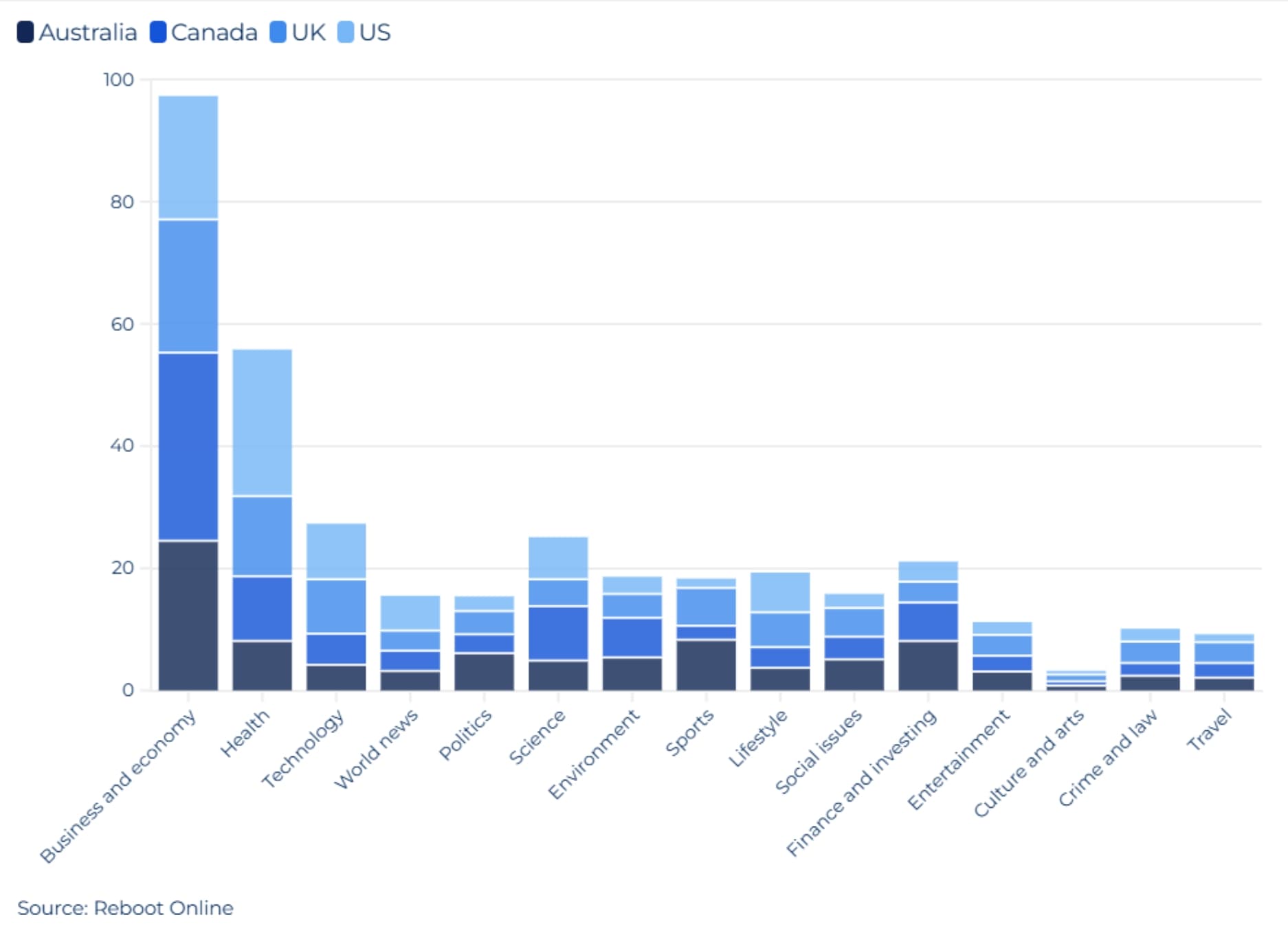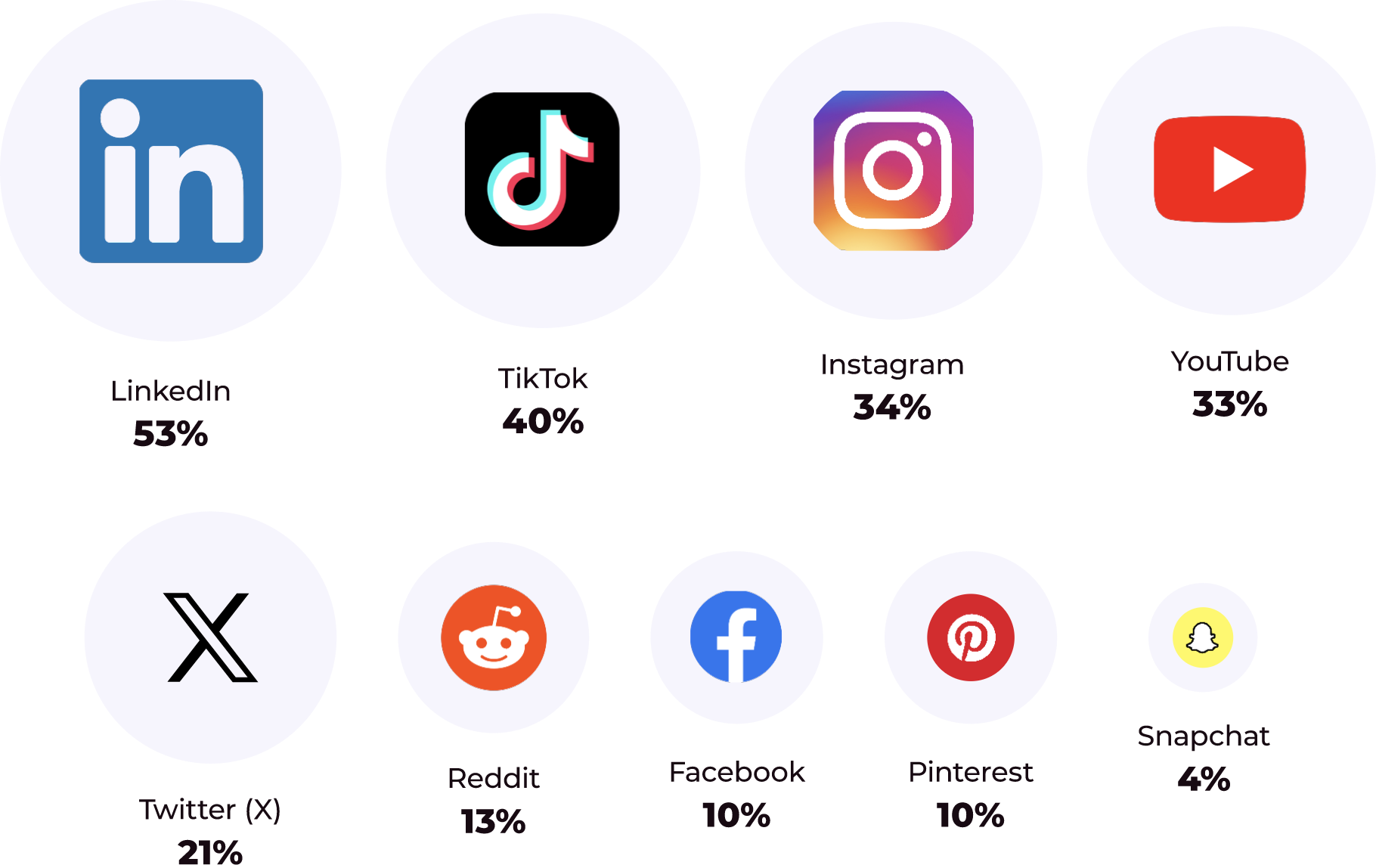How are news publications sharing digital PR campaigns?
Most popular online media outlets for digital PR
It’s estimated that the average American spends around 8 hours per day digesting digital media. This is perhaps unsurprising given that analysis by digital PR agency Reboot Online found online news to be the main source of information for almost three-quarters (72%) of Americans when it came to news stories and current affairs.
This trend is apparent in other parts of the world too, notably the UK, when the internet replaced TV as the most popular news source for the first time in 2024 (71% vs. 70%, respectively).
FIGURE 10: TOP MEDIA OUTLETS FOR ONLINE NEWS IN THE US AND UK (2024)
SOURCE: WEBFX
The BBC website was the most popular news outlet in the UK in 2024, used by almost three-fifths (59%) of people to access news updates.
The UK's most popular online news outlet in 2024 was the BBC website, used by almost three-fifths (59%) of people throughout the year to access news.
Around a fifth (20%) of people either went to Sky News or The Guardian/Observer as their primary source of online news, followed closely by The Daily Mail (19%).
Conversely, in the US, the split between online news outlets was much more even in 2024. Local TV news was the most popular source for just over a quarter (28%) of people, followed by Fox News (27%).
Learn how you can get more leads and enquiries with a local SEO company by ranking at the top of the organic search results in your niche.
FIGURE 11: TOP SOCIAL MEDIA, MESSAGING, AND VIDEO NETWORKS FOR NEWS IN THE US AND UK (2024)
SOURCE: REUTERS INSTITUTE, UNIVERSITY OF OXFORD, AND OFCOM
As of 2024, Facebook was the most popular social media platform for news in the UK and the US, with just under a third of adults from each country using it to access news updates regularly (30% and 31%, respectively).
This is contrasted by just under 1 in 3 (29%) adults in the US who use YouTube to access the news, compared to less than 1 in 5 19%) UK adults.
In 2020, around 1% of adults in the UK used TikTok to obtain news information – a figure that rose to 11% in 2024 (the largest increase across all social media platforms during this time). This is compared to less than 1 in 10 (9%) US adults who turn to TikTok when it comes to watching the news via social media.
Most common digital PR news articles by sector
According to an analysis by digital PR company Reboot Online of more than 370,000 news articles, the most common industry to be represented in digital PR news across 2024 was business and the economy. This accounted for around 1 in 5 (22.2%) articles across selected English-speaking countries.
This was followed by those from the health sector (13.6%) and technology (6.5%), and mirrors the general pattern shown in UK-based articles.
Business and the economy were the most popular industries from digital PR news articles in 2023-24, accounting for more than 1 in 5 (22%).
FIGURE 12: MOST COMMON DIGITAL PR NEWS ARTICLES BY INDUSTRY ACROSS SELECTED ENGLISH-SPEAKING COUNTRIES
SOURCE: REBOOT ONLINE
NOTE: FIGURES ABOVE ARE REPRESENTED AS PERCENTAGES
This trend was reversed in the US, with around a quarter (24%) of analysed news articles covering health-related topics, followed by around a fifth (20.2%) for business and the economy.
TABLE 5: MOST COMMON DIGITAL PR NEWS ARTICLES BY INDUSTRY ACROSS SELECTED ENGLISH-SPEAKING COUNTRIES
| Industry |
Australia |
Canada |
UK |
US |
Total result |
| Business and economy |
24.5% |
30.8% |
21.8% |
20.2% |
22.2% |
| Health |
8.1% |
10.6% |
13.1% |
24.0% |
13.6% |
| Technology |
4.2% |
5.1% |
8.9% |
9.1% |
6.6% |
| World news |
3.2% |
3.3% |
3.3% |
5.7% |
6.5% |
| Politics |
6.1% |
3.1% |
3.8% |
2.4% |
6.3% |
| Science |
4.9% |
8.9% |
4.4% |
6.9% |
6.3% |
| Environment |
5.4% |
6.5% |
3.9% |
2.8% |
5.4% |
| Sports |
8.3% |
2.3% |
6.2% |
1.5% |
4.1% |
| Lifestyle |
3.7% |
3.4% |
5.7% |
6.5% |
3.8% |
| Social issues |
5.1% |
3.7% |
4.7% |
2.3% |
3.7% |
| Finance and investing |
8.1% |
6.3% |
3.4% |
3.3% |
3.7% |
| Entertainment |
3.1% |
2.6% |
3.4% |
2.1% |
2.8% |
| Culture and arts |
0.8% |
0.7% |
1.1% |
0.6% |
2.3% |
| Crime and law |
2.4% |
2.1% |
3.5% |
2.1% |
2.2% |
| Travel |
2.1% |
2.4% |
3.4% |
1.3% |
2.1% |
SOURCE: REBOOT ONLINE
The largest proportion of articles relating to business and the economy was in Canada, with around a third (30.8%) falling under this category, followed by approximately 1 in 10 (10.6%) for health.
One of the appeals of digital PR is its versatility and how it applies to various sectors, niches, and fields. For more details, check out some examples of the various digital PR industries we work with and how we could help grow your business.
TABLE 6: MOST POPULAR DIGITAL PR NEWS ARTICLES BY CLASSIFICATION AND INDUSTRY
| Industry |
AI-reimagined (%) |
Data ($) |
Expert comment |
Index study (%) |
Infographics (%) |
Mapped (%) |
Survey study (%) |
| Business and economy | 24.0% | 24.23% | 14.80% | 57.12% | 24.76% | 14.09% | 21.53% |
| Politics | 0.41% | 3.49% | 2.20% | 5.00% | 4.71% | 2.72% | 20.19% |
| Health | 8.87% | 21.90% | 16.53% | 4.77% | 15.90% | 5.14% | 11.56% |
| Social issues | 0.13% | 6.72% | 0.86% | 5.92% | 1.45% | 1.37% | 7.73% |
| World news | 0.50% | 6.94% | 3.34% | 5.22% | 12.79% | 5.88% | 4.60% |
| Technology | 28.91% | 4.17% | 4.60% | 2.39% | 8.69% | 8.43% | 4.23% |
| Entertainment | 4.94% | 0.99% | 3.67% | 0.12% | 2.42% | 3.89% | 3.72% |
| Lifestyle | 0.10% | 0.78% | 15.12% | 0.18% | 1.74% | 0.86% | 3.56% |
| Environment | 0.47% | 5.93% | 4.38% | 3.21% | 2.82% | 12.48% | 3.07% |
| Sports | 7.21% | 1.88% | 9.66% | 0.20% | 3.43% | 3.85% | 2.84% |
| Travel | 0.10% | 1.87% | 4.25% | 1.09% | 1.08% | 1.26% | 2.76% |
| Finance and investing | 4.28% | 3.21% | 7.86% | 4.17% | 4.16% | 0.50% | 2.72% |
| Education | 0.23% | 2.25% | 0.95% | 1.26% | 2.44% | 2.07% | 2.09% |
| Crime and law | 0.16% | 4.34% | 1.20% | 0.38% | 2.25% | 2.52% | 1.50% |
| Science | 16.97% | 3.73% | 1.39% | 1.00% | 2.57% | 22.06% | 1.31% |
| Local news | 0.02% | 0.83% | 0.31% | 0.22% | 1.22% | 2.33% | 1.10% |
| National news | 0.00% | 1.19% | 0.06% | 0.71% | 0.19% | 0.35% | 0.91% |
| Culture and arts | 1.83% | 0.41% | 2.23% | 0.08% | 4.31% | 4.66% | 0.89% |
| Automotive | 0.05% | 0.94% | 1.07% | 1.25% | 0.42% | 0.61% | 0.81% |
| Human interest stories | 0.15% | 0.36% | 0.69% | 0.13% | 0.52% | 1.29% | 0.78% |
| Real estate | 0.07% | 1.65% | 0.83% | 5.04% | 0.55% | 0.50% | 0.58% |
| Food and drink | 0.15% | 0.36% | 1.64% | 0.13% | 0.36% | 0.51% | 0.51% |
| Public safety | 0.00% | 0.55% | 0.07% | 0.01% | 0.11% | 0.34% | 0.32% |
| Religion and spirituality | 0.07% | 0.06% | 0.04% | 0.00% | 0.09% | 0.05% | 0.24% |
| Opinion and editorials | 0.15% | 0.07% | 0.26% | 0.00% | 0.19% | 0.26% | 0.19% |
| Parenting and family | 0.02% | 0.20% | 1.06% | 0.00% | 0.02% | 0.05% | 0.15% |
| Weather | 0.06% | 0.86% | 0.33% | 0.17% | 0.55% | 0.58% | 0.05% |
| History | 0.02% | 0.06% | 0.06% | 0.04% | 0.23% | 1.22% | 0.04% |
| Fashion and style | 0.07% | 0.03% | 0.55% | 0.17% | 0.02% | 0.13% | 0.02% |
SOURCE: REBOOT ONLINE
Reboot’s analysis of digital PR statistics found that the most common classification for campaigns in 2024 was an index study, accounting for almost three-fifths (57.12%) of business and economy-related news articles across the year.
This sector was also responsible for around a quarter (24.76%) of infographics and data studies (24.23%) across all industries, as well as more than a fifth of surveys (21.53%).
The analysis also found that:
- AI-reimagined pieces are a growing trend, but as of 2024, they tend to feature more in the technology sector (28.91% of articles).
- Mapped studies are most common in the science sector, at around 1 in 5 (22.06%) articles.
- Expert comments are the least favoured classification of digital PR campaigns, with health and lifestyle being the areas they are most likely to appear in (16.53% and 15.12%, respectively).
Sentiment analysis of news articles
Just under half (48.5%) of the digital PR news articles analysed by Reboot from selected English-speaking countries were found to contain positive sentiment analysis. This figure was highest in the UK, where 51.1% of the articles assessed had positive connotations, followed by Canada at 51%.
Just under half (48.5%) of news articles analysed in 2023-24 had positive sentiments, with just over a fifth (22.4%) for negative.
FIGURE 13: SENTIMENT ANALYSIS OF DIGITAL PR NEWS ARTICLES ACROSS SELECTED ENGLISH-SPEAKING COUNTRIES
SOURCE: REBOOT ONLINE
Conversely, just over a fifth (22.4%) of digital PR campaigns displayed negative sentiment. This was proportionally higher in the US, where around a third (33.3%) of articles were deemed to be negative in nature. This was contrasted by just over a quarter (25.9%) of news pieces in neighbouring Canada.
“Digital PR campaigns are inherently linked to a company and its branding. Therefore, making a positive impression with their target audience is key to attracting new customers and retaining existing ones. Building a positive brand image should help benefit brand awareness and foster trust with people. Negative PR campaigns, while attention-grabbing, tend to be quite reactive. This could have the opposite effect and indeed damage a company’s reputation.”
BETH SURRIDGE
SENIOR DIGITAL PR MANAGER, REBOOT ONLINE
FIGURE 14: SENTIMENT ANALYSIS OF NEWS ARTICLES BY CAMPAIGN TYPE
SOURCE: REBOOT ONLINE
A study of more than 370,000 digital PR articles by Reboot Online found that those containing expert comments tend to have the largest degree of positive sentiment at just under two-thirds (63.7%). This is followed by AI-reimagined pieces and infographics, both at just over half (53% and 51%, respectively).
On the flip side, around two-fifths (41.7%) of the articles analysed displayed a negative sentiment analysis – the highest recorded percentage across all digital PR campaign types. This was followed by surveys and infographics, where almost a third (32.8% and 32%, respectively) were deemed to have a negative angle to their content.
TABLE 7: SENTIMENT ANALYSIS OF NEWS ARTICLES BY CAMPAIGN TYPE
| Classification |
Positive |
Neutral |
Negative |
| Automotive | 63.0% | 19.2% | 17.8% |
| Business and economy | 61.4% | 20.0% | 18.6% |
| Crime and law | 10.0% | 10.2% | 79.8% |
| Culture and arts | 62.5% | 20.7% | 16.9% |
| Education | 61.0% | 19.5% | 19.5% |
| Entertainment | 56.9% | 20.7% | 22.4% |
| Environment | 29.5% | 30.6% | 40.0% |
| Fashion and style | 85.1% | 9.4% | 5.4% |
| Finance and investing | 59.4% | 19.7% | 20.9% |
| Food and drink | 76.1% | 14.3% | 9.6% |
| Health | 27.3% | 20.8% | 51.9% |
| History | 23.8% | 41.5% | 34.7% |
| Human interest stories | 52.6% | 15.4% | 32.0% |
| Lifestyle | 66.9% | 16.7% | 16.4% |
| Local news | 47.7% | 23.6% | 28.7% |
| National news | 22.0% | 30.7% | 47.3% |
| Opinion and editorials | 60.4% | 13.1% | 26.5% |
| Parenting and family | 76.3% | 12.6% | 11.1% |
| Politics | 45.7% | 19.4% | 34.9% |
| Public safety | 18.2% | 11.8% | 70.0% |
| Real estate | 46.2% | 36.2% | 17.7% |
| Religion and spirituality | 35.8% | 15.4% | 48.8% |
| Science | 42.1% | 43.4% | 14.5% |
| Social issues | 27.5% | 16.5% | 56.1% |
| Sports | 63.5% | 18.1% | 18.4% |
| Technology | 63.0% | 19.9% | 17.1% |
| Travel | 64.4% | 22.5% | 13.1% |
| Weather | 13.2% | 14.8% | 72.1% |
| World news | 19.4% | 38.8% | 41.8% |
SOURCE: REBOOT ONLINE
In terms of sentiment analysis by sector, the overwhelming majority (85.1%) of articles analysed in the fashion and style industry had positive connotations. This was followed by parenting and family, and food and drink, where around three-quarters (76.3% and 76.1%, respectively) were positive in their content.
On the other side, the crime and law sector tends to show the largest degree of negative sentiment when it comes to digital PR campaigns. Almost 4 in 5 (79.8%) articles analysed fell into this category – almost 7% more than the next category (weather) at 72.1%.



























